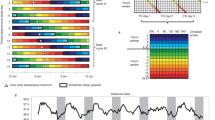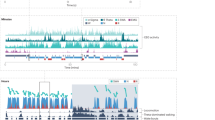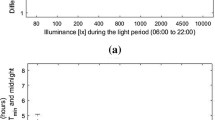Abstract
Circadian rhythms are known to exist in many measures of human performance efficiency as well as in physiological processes1. The demands of a task, and in particular its ‘working memory’2 load, play a large part in determining the time of day at which it is best performed3. Furthermore, task demands may affect the speed with which performance rhythms adjust to the altered sleep/wake schedules occasioned by shift-work and rapid time-zone transitions4. These differences in rate of adjustment may be explained by a similar multi-oscillatory model to those proposed for physiological rhythms5–10. These assume any given circadian rhythm to be jointly controlled by two endogenous oscillators. The first is thought to be relatively immune to exogenous factors and to control the temperature rhythm, while the second is thought to be more influenced by exogenous factors and to have the major role in governing the sleep/wake cycle. Normally, the pronounced 24-h time cues, or ‘Zeitgebers’, in our environment result in both oscillators, and hence all circadian rhythms, running with a period of 24 h. However, under altered sleep/wake schedules, and in conditions of temporal isolation, the temperature rhythm and sleep/wake cycle may separate from one another and run with distinctly different periods. When such ‘internal desynchronization’ occurs, other physiological rhythms have been found to run in synchrony with one or other of these two functions. This finding forms the basis of current multi-oscillatory models. However, studies of abnormal sleep/wake schedules suggest that the rhythm in working memory performance may sometimes separate from both the sleep/wake cycle and temperature rhythm by running with a period of less than 24 h11. We have investigated this possibility here and our results indicate control of working memory performance rhythms by a previously unidentified oscillator with an autonomous period of about 21 h.
This is a preview of subscription content, access via your institution
Access options
Subscribe to this journal
Receive 51 print issues and online access
$199.00 per year
only $3.90 per issue
Buy this article
- Purchase on Springer Link
- Instant access to full article PDF
Prices may be subject to local taxes which are calculated during checkout
Similar content being viewed by others
References
Blake, M. J. F. Psychon. Sci. 9, 349–350 (1967).
Baddeley, A. D. & Hitch, G. in Advances in Research and Theory Vol. 8 (ed. Bower, G. A.) 47–90 (Academic, New York, 1974).
Folkard, S. in Rhythmic Aspects of Behaviour (eds Brown, F. M. & Graeber, R. C.) 241–272 (Erlbaum, Hillsdale, New Jersey, 1982).
Folkard, S. & Monk, T. H. Hum. Factors 21, 483–492 (1979).
Wever, R. A. Int. J. Chronobiol. 3, 19–55 (1975).
Wever, R. A. The Circadian System of Man : Results of Experiments under Temporal Isolation (Springer, New York, 1979).
Kronauer, R. E., Czeisler, C. A., Pilato, S. F., Morre-Ede, M. C. & Weitzman, E. D. Am. J. Phys. 242, R3–R17 (1982).
Wever, R. A. Am. J. Phys. 242, R17–R21 (1982).
Daan, S. & Berde, C. J. theor. Biol. 70, 297–313 (1978).
Takahashi, J. S. & Zatz, M. Science 217, 1104–1111 (1982).
Folkard, S. & Monk, T. H. in Psychophysiology : Memory, Motivation and Event-related Potentials in Mental Operations (eds Sinz, R. & Rosenweig, M. R.) 541–548 (Gustav Fischer, Jena, Elsevier, Amsterdam, 1982).
Wever, R. A. Pflügers Arch. ges. Physiol. 396, 128–137 (1983).
Baddeley, A. D. Psychon. Sci. 19, 341–342 (1968).
Folkard, S. Br. J. Psychol. 66, 1–8 (1975).
Folkard, S., Knauth, P., Monk, T. H. & Rutenfranz, J. Ergonomics 19, 479–488 (1976).
Minors, D. S. & Waterhouse, J. M. Circadian Rhythms and the Human, 311–319 (Wright, Bristol, 1981).
Monk, T. H. & Fort, A. Int. J. Chronobiol. (in the press).
Wever, R. A., Polasek, J. & Wildgruber, C. Pflügers Arch. ges. Physiol. 396, 85–87 (1983).
Wever, R. A. in Rhythmic Aspects of Behaviour (eds Brown, F. M. & Braeber, R. C.) 105–171 (Erlbaum, Hillsdale, New Jersey, 1982).
Author information
Authors and Affiliations
Rights and permissions
About this article
Cite this article
Folkard, S., Wever, R. & Wildgruber, C. Multi-oscillatory control of circadian rhythms in human performance. Nature 305, 223–226 (1983). https://doi.org/10.1038/305223a0
Received:
Accepted:
Issue Date:
DOI: https://doi.org/10.1038/305223a0
This article is cited by
-
Influence of time-of-day on joint Navon effect
Cognitive Processing (2018)
-
Circadian rhythms and memory formation
Nature Reviews Neuroscience (2010)
-
Circadian oscillation of hippocampal MAPK activity and cAMP: implications for memory persistence
Nature Neuroscience (2008)
-
Establishing the presence of a body temperature rhythm in chimpanzees (Pan troglodytes) using a tympanic membrane thermometer
Primates (1999)
-
Pattern of shift rota modulates oral temperature circadian rhythm and sleep-wakefulness profiles in shift workers
Journal of Biosciences (1997)
Comments
By submitting a comment you agree to abide by our Terms and Community Guidelines. If you find something abusive or that does not comply with our terms or guidelines please flag it as inappropriate.



